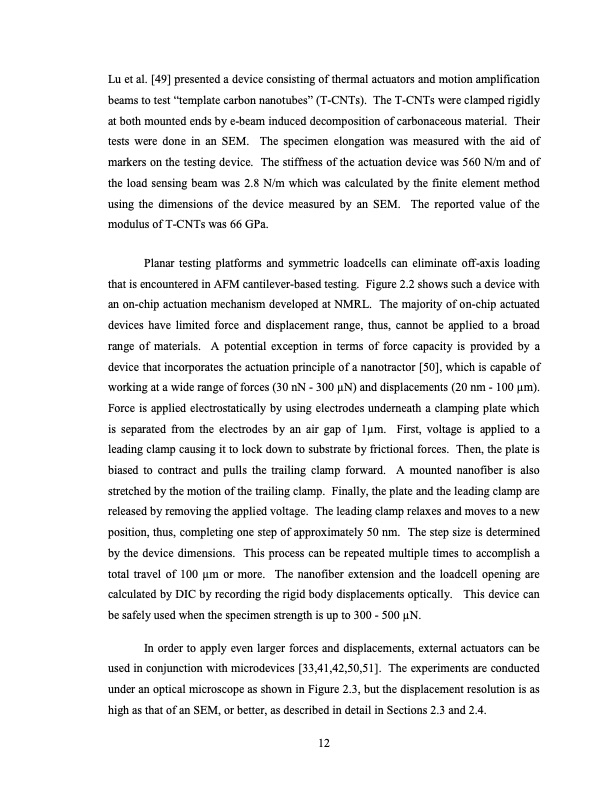
PDF Publication Title:
Text from PDF Page: 019
Lu et al. [49] presented a device consisting of thermal actuators and motion amplification beams to test ―template carbon nanotubes‖ (T-CNTs). The T-CNTs were clamped rigidly at both mounted ends by e-beam induced decomposition of carbonaceous material. Their tests were done in an SEM. The specimen elongation was measured with the aid of markers on the testing device. The stiffness of the actuation device was 560 N/m and of the load sensing beam was 2.8 N/m which was calculated by the finite element method using the dimensions of the device measured by an SEM. The reported value of the modulus of T-CNTs was 66 GPa. Planar testing platforms and symmetric loadcells can eliminate off-axis loading that is encountered in AFM cantilever-based testing. Figure 2.2 shows such a device with an on-chip actuation mechanism developed at NMRL. The majority of on-chip actuated devices have limited force and displacement range, thus, cannot be applied to a broad range of materials. A potential exception in terms of force capacity is provided by a device that incorporates the actuation principle of a nanotractor [50], which is capable of working at a wide range of forces (30 nN - 300 μN) and displacements (20 nm - 100 μm). Force is applied electrostatically by using electrodes underneath a clamping plate which is separated from the electrodes by an air gap of 1μm. First, voltage is applied to a leading clamp causing it to lock down to substrate by frictional forces. Then, the plate is biased to contract and pulls the trailing clamp forward. A mounted nanofiber is also stretched by the motion of the trailing clamp. Finally, the plate and the leading clamp are released by removing the applied voltage. The leading clamp relaxes and moves to a new position, thus, completing one step of approximately 50 nm. The step size is determined by the device dimensions. This process can be repeated multiple times to accomplish a total travel of 100 μm or more. The nanofiber extension and the loadcell opening are calculated by DIC by recording the rigid body displacements optically. This device can be safely used when the specimen strength is up to 300 - 500 μN. In order to apply even larger forces and displacements, external actuators can be used in conjunction with microdevices [33,41,42,50,51]. The experiments are conducted under an optical microscope as shown in Figure 2.3, but the displacement resolution is as high as that of an SEM, or better, as described in detail in Sections 2.3 and 2.4. 12PDF Image | HIGH STRENGTH CARBON NANOFIBERS DERIVED FROM ELECTROSPUN POLYACRYLONITRILE

PDF Search Title:
HIGH STRENGTH CARBON NANOFIBERS DERIVED FROM ELECTROSPUN POLYACRYLONITRILEOriginal File Name Searched:
4835609.pdfDIY PDF Search: Google It | Yahoo | Bing
Sulfur Deposition on Carbon Nanofibers using Supercritical CO2 Sulfur Deposition on Carbon Nanofibers using Supercritical CO2. Gamma sulfur also known as mother of pearl sulfur and nacreous sulfur... More Info
CO2 Organic Rankine Cycle Experimenter Platform The supercritical CO2 phase change system is both a heat pump and organic rankine cycle which can be used for those purposes and as a supercritical extractor for advanced subcritical and supercritical extraction technology. Uses include producing nanoparticles, precious metal CO2 extraction, lithium battery recycling, and other applications... More Info
| CONTACT TEL: 608-238-6001 Email: greg@infinityturbine.com | RSS | AMP |